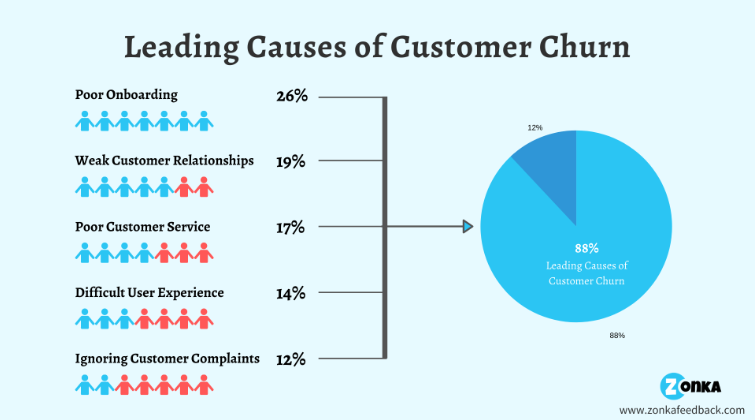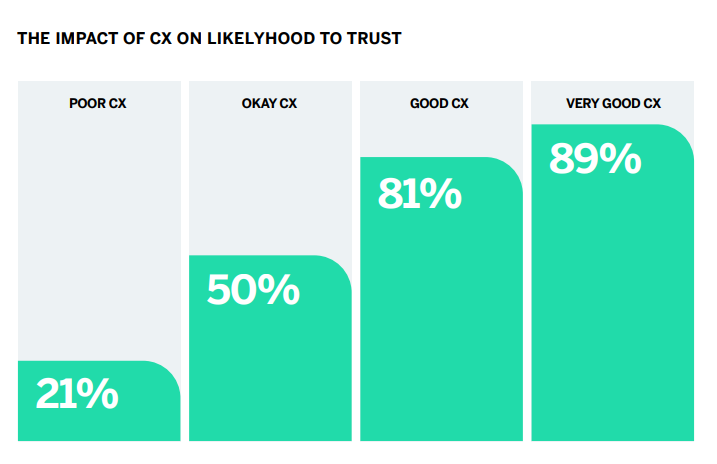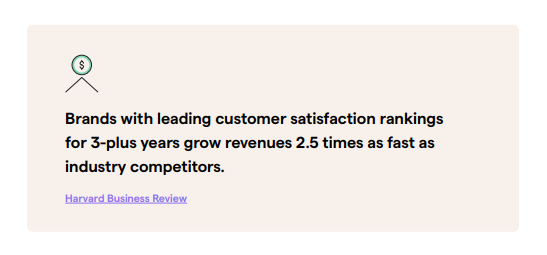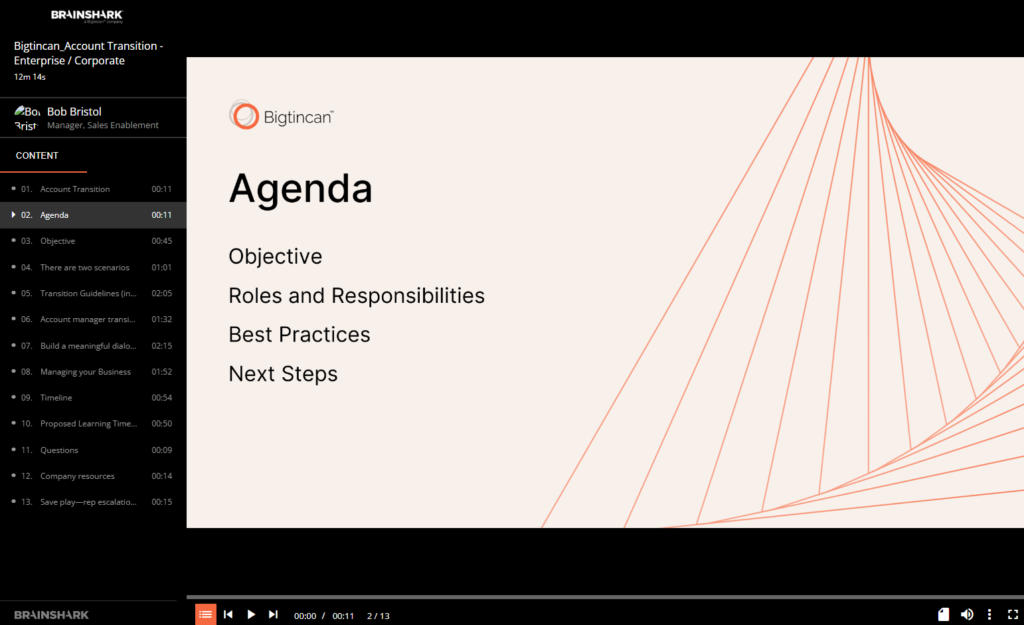The state of customer experience and churn
Is 2023 the year businesses finally rediscover human connection?
According to Qualtrics XM, it is. And we’re all for it.
Poor customer experience is a known (MAJOR) contributor to customer churn.

So it isn’t exciting news that Qualtrics XM found that out of 33,000 consumers surveyed, 36% are unhappy with the empathy shown in their customer service interactions (2023 Global Consumer Trends Report). They also outlined three ways companies can improve customer satisfaction in coming years:
- Find the human connection to win hearts, minds, and loyalty
- Get closer to customers to differentiate and win in a down market
- Understand how people really feel through more genuine, human listening
One opportunity to put these concepts into practice is during the account manager transition process, which a majority of companies tend to start at the turn of the new year.
Get more customer-centric strategies in this Heinz research report Roadblocks to Delivering a Competitive Buying Experience.
De-risking the account transition process
Transitioning account managers (changing out one customer relationship owner for another) can be disruptive for both internal teams and, more importantly, customers. In touchy times like these there’s a higher than usual risk of churn, which makes regular processes more perilous.

Qualtrics XM ROI of customer experience 2021
To de-risk the account transition process and keep customer trust, companies need an empathetic, customer-centric strategy for smoothly introducing new account managers. That’s why we’re providing one — and pulling from our own experience of doing this successfully at the turn of our 2022/23 fiscal year.
The TLDR is to have a plan and execute it with empathy. Get the best practices and guidelines from the Bigtincan sales enablement team as well as a downloadable checklist that will aid you in your own process below.
Download your account transition checklist.
Best practices for a customer-centric sales contact transition
1. Come up with a process for identifying key and at risk accounts
While you need to make it clear to every customer that they are valued throughout this process (and always), be sure to take extra care with those who may be at risk. Look at past data like exit interviews, customer reviews, and account activity to establish common churn risk factors among your customer base, such as:
- Low adoption rates
- Low NPS (Net Promoter Score) or CSAT (Customer Satisfaction Score)
- Stakeholder turnover (lost your champion or buyer)
- Ongoing product issues/outstanding support tickets
- No contact within last couple months
- Financial and market conditions being experienced by your client

After you have risk criteria in place, each account manager (AM) needs to comb their client base for these indicators and prioritize at-risk accounts to focus on. You may use a number ranking system or color-coded account statuses, such as Red/Yellow/Green in SFDC, or another CRM dashboard.
2. Draft a “save plan”
Once you identify at-risk customers, draft a “save plan” for reviving these accounts that includes a strategy for mitigating each risk factor.
For example, if the customer has low adoption rates the AM can work with the Customer Success Manager (CSM) to initiate product training sessions. They can also send the customer content detailing product features and benefits so they understand the value and how to use them correctly.
Set up a payment plan for financial difficulties, and so on.
Include an escalation strategy as part of your save plan so all account managers know who to call on if conversations don’t go as planned. Is there someone in your organization that has great rapport with a particular customer, such as the original sales rep who brought them in? Will a chat between your CEO and the customer’s CEO turn things around? Make note of who to call in each customer case when detailing the plan for each account.
Make the importance of these follow-up actions clear to stakeholders outside of account management, such as engineers, executives, and CSMs, so they don’t become bottlenecks.
See also: It takes a village — how to get your entire company to enable sales
3. Set a timeline
To make the process efficient and effective, set an ideal timeline for when the transition should be completed. This will not be a “one and done” event, so plan on at least a few weeks to coordinate the handoff between account managers and conduct all the meetings required for a smooth, thorough, and unrushed process.
Such meetings might include:
- Feedback gathering
- Introductions
- Paperwork and other administrative tasks
The timeline may change based on the individual customers or account managers, but be sure to set a target date so the transition doesn’t drag on (which also isn’t a great customer experience).
4. Personalize the handoff
While it’s good to have general guidelines, keep in mind that a customer-centric approach is not a one-size-fits-all approach.

To act with empathy and build that human connection, you need to personalize the handoff for each account by having the previous and incoming account managers, as well as CSMs, coordinate. Form a mini “task force” for each account that meets regularly throughout this process to share information and establish the best, unique approach according to the customer’s individual needs.
To truly personalize the approach, new AMs need to understand the customer by:
- Researching the customer’s industry and trends
- Review their account status and support tickets
- Review their account notes and contracts in SFDC or other CRM
- Understand their original use case for your product/services
- Identify what their upcoming six-month initiatives are
- Set up or get added to standing calls
5. Conduct a meaningful dialogue
Once the internal team has debriefed, it’s time for the new AM to talk (and really listen) to the customer. Before picking up the phone, they should understand:
- Their corporate structure
- What their products are
- Who their customers are
- How their use of your company’s products or services has changed over time or might change in the future
- If they have any releases coming up
Begin the dialogue by explaining the reason for the switch and what the value is for the customer — such as easier communication, eliminating confusion, or providing better service.
Gather their direct feedback on what will make this process more helpful for them and deliver on those points.
Take the time to get to know the customer, their concerns, their preferences, their future plans. Some casual conversation unrelated to the business also helps build that human connection.
Further reading: Helping Sellers Become Buyer Ready
6. Provide support for the account reps throughout the process
Make sure your sales managers and/or sales enablement team are supporting the account managers throughout the transition, especially the less tenured reps.

In our case, the AMs had a timeline to march towards, reinforcement training on best practices, and regular learning sessions during each phase of the account transition rollout delivered through our own sales enablement solutions, Brainshark and Bigtincan.
According to Robert Bristol, our Senior Sales Enablement Manager at Bigtincan, “The two biggest takeaways were providing the guidance for those less tenured Account Managers on how to initiate better discussions with their accounts and the clear value the increased interaction between the Account Manager and the Customer Success team has for the customer.”
7. Save expansion deals for later
The purpose of building human connection is defeated if the only motivation is a dollar sign. So while you can keep the 80/20 principle in mind, don’t use this time to push expansion deals.
Customers won’t appreciate it if their first few interactions with their new account manager are upsell pitches. You’ll sour the relationship from the start and end up churning the customer away.
If there are deals already in play, let the current or outgoing account manager complete those before handing things off to the new rep (within a reasonable timeframe, such as 60-90 days).
